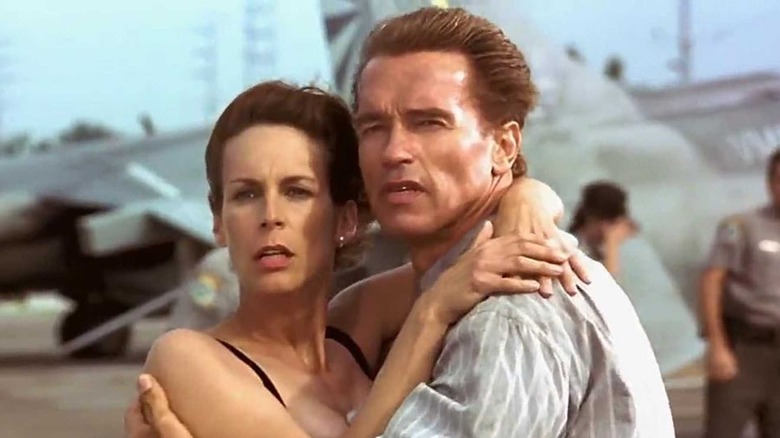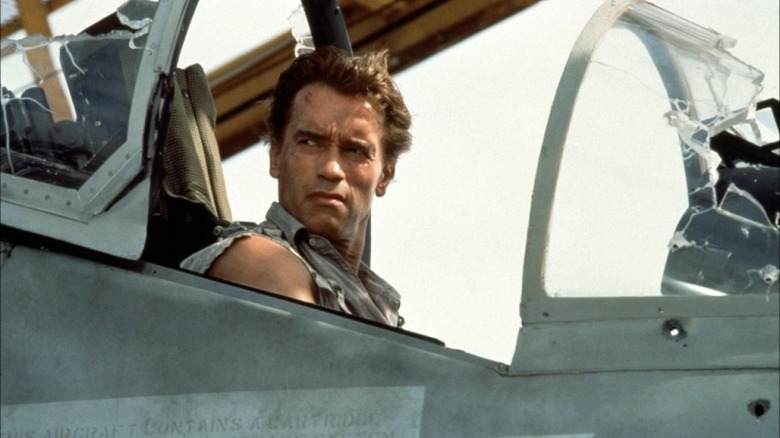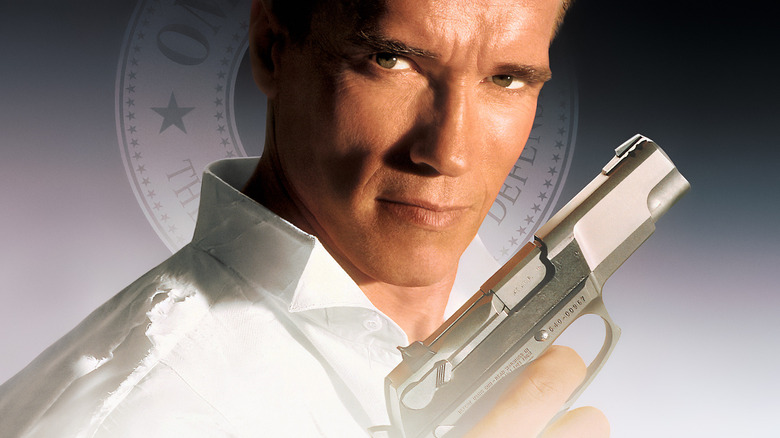Shooting Arnold Schwarzenegger In Front Of A Green Screen Wasn't Going To Work For The Climax Of True Lies
The climax of the 1994 action film "True Lies" saw Harry Tasker (Arnold Schwarzenegger) commandeering a Harrier jet — the kind that can hover in midair like a helicopter — to rescue his kidnapped daughter, Dana (Eliza Dushku) from a terrorist character named Aziz (Art Malik). To add tension to the proceedings, Dana is dangling precariously from a crane while Harry and Aziz tussle from the cockpit. Aziz is bested when he falls from the top of the jet, becoming tangled on one of the jet's missiles. "You're fired," Harry quips, as he fires the missile with Aziz attached. A big fun, dumb ending to a big fun, dumb movie.
"True Lies" was directed by James Cameron, a director who rarely takes the easy route when it comes to creating spectacular special effects; this is the same person who took 13 years to make a sequel to "Avatar" because effects technology wasn't up to snuff. The safer, easier way to film a sequence like the one in "True Lies" would be to construct the cockpit portion of a Harrier jet, seat Schwarzenegger in it, place the rig in front of an indoor studio green screen, and then key in an artificial background — a bright, outdoor cityscape in this case — in post-production. Add camera shakes and clever angles, and a filmmaker can reasonably create the desired effect. But of course, that's not what Cameron did.
The 7,000 pound jet model
This kind of green screen filming has become something of the norm in modern blockbuster filmmaking, allowing filmmakers to place live-action actors into whatever complex digital fantasy environs they can imagine. And while digital effects have become more and more convincing as time passes, there are definite limitations to the green screen approach. Most notably, actors cannot interact with their environment: A character may look like they are in a 3-D space, but when they can only move in a 10-foot-by-10-foot square, it limits the action of a scene. Cameron, in hoping to avoid this "crunch," elected to film in a more natural environment. Using a complex system of cranes and rigs, the effects technicians on "True Lies" hoisted an actual scale model Harrier jet (a real one would have been too heavy and expensive) high above an actual Miami street. For this climax, a green screen would not be acceptable.
In a VFX TV special from 1994, called simply "Movie Magic," "True Lies'" VFX producer John Bruno said that Cameron pushed verisimilitude. The audience have to believe that Harry was actually flying a jet. Cameron was also fond of the "X factors" that location shooting provided. Said Cameron:
"When you move out of the clinical laboratory environment of a soundstage, you're subject to all the forces of nature: Wind, rain, overcast, changing light during the day. One we didn't really think of, which was lightning, except that we went down there to scout the location, and we went up on the roof and there were lightning rods every 6 feet all the way around the roof. We went, 'Hmm.' Things that make you go hmm."
The film's dark legacy
The jet was then controlled by a then-revolutionary computerized motion-control system that could push the 7,000 pound model — on a massive, complex system of hydraulics — in a more dynamic way than was previously achievable. With exactly-programmed movements in play, the camera's POV could be more carefully planned.
Although Bruno admits to being a little nervous about the whole endeavor — a project of that scale hadn't been tried before. Like many of Cameron's productions, it was complex and expensive. Bruno said he relaxed when he overheard Schwarzenegger talking to Cameron:
"Well at first everybody was kind of nervous because of the scale of this whole thing. You know, it was a 20,000 pound motion base and 7,000 pound jet on the top of a roof with these huge hydraulic systems, you know, spinning around and moving around. You know, I overheard Arnold say to Jim, he goes, 'You know, Jim, this is the money.' I mean, he's sitting in the jet, 'This is the money. This is where the money is. This is great.' I overheard that, and that sort of relaxed me, because I was, like, stressed a little bit."
"True Lies" was a huge hit when it came out, and is one of the bolder, slicker action spectacles of its era. It also is a controversial film for its regressive attitudes; there has always been outcry over the film's very casual sexism and racial stereotypes. There were complaints upon its opening, and some critics have lambasted the film's striptease number as being horrible for women. Watching "True Lies" is certainly a snapshot of where American A-budget action filmmaking was in 1994. Certainly some irresponsible messaging, but golly if those effects don't hold up.
A "True Lies" TV series is currently in the works.


